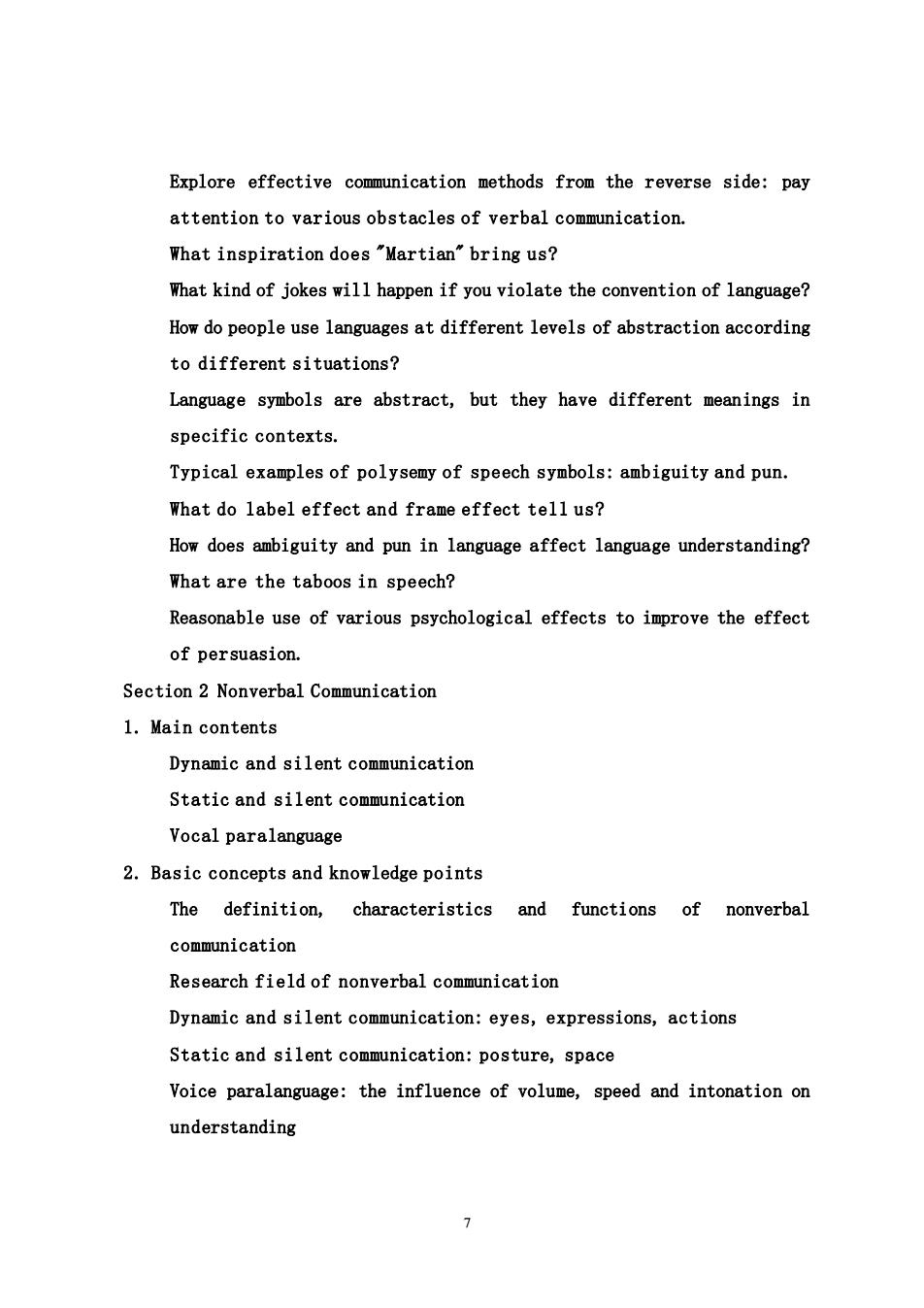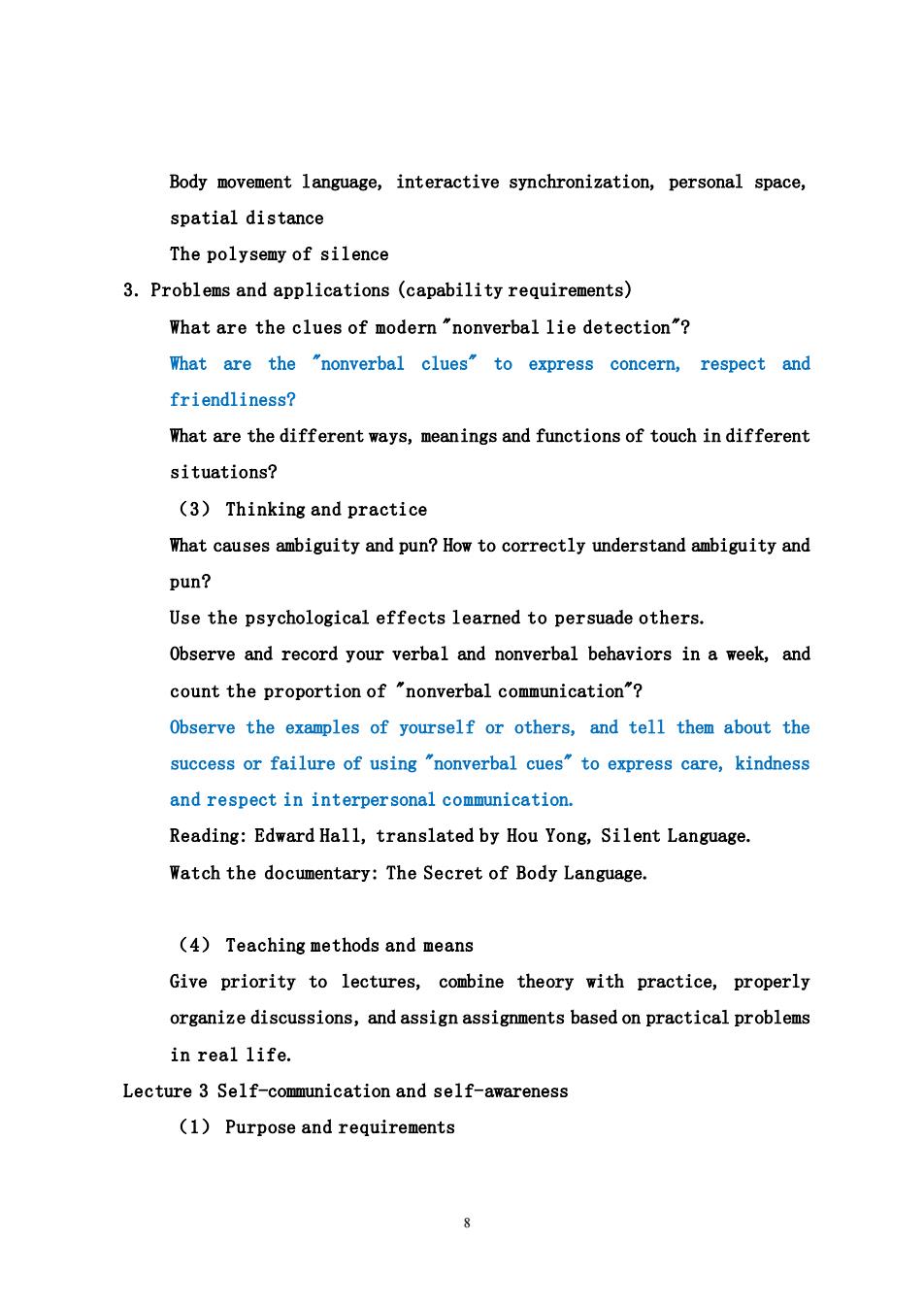
Lecture 2 Verbal communication and non-verbal communication (1)Purpose and requirements Knowledge:the definition and characteristics of verbal communication and nonverbal communication and related psychological research Ability:the application of verbal communication and nonverbal communication in communication Ideological and political aims:encourage and inspire students to treat others sincerely,respect each other,care for each other,and be friendly and harmonious through observing and applying effective verbal and nonverbal clues,and strive to form a new socialist interpersonal relationship. (2)Teaching content Section I Verbal Communication 1.Main contents What is verbal communication? Characteristics of speech symbols Psychological Research on Speech Communication Application:the psychological effect of persuasion 2.Basic concepts and knowledge points Definition and classification of verbal communication The development and characteristics of verbal communication symbols The influence of language on cognition and understanding:label effect and frame effect Commitment effect Threshold effect and face-saving effect 3.Problems and applications (capability requirements)
6 Lecture 2 Verbal communication and non-verbal communication (1) Purpose and requirements Knowledge: the definition and characteristics of verbal communication and nonverbal communication and related psychological research Ability: the application of verbal communication and nonverbal communication in communication Ideological and political aims: encourage and inspire students to treat others sincerely, respect each other, care for each other, and be friendly and harmonious through observing and applying effective verbal and nonverbal clues, and strive to form a new socialist interpersonal relationship. (2) Teaching content Section I Verbal Communication 1. Main contents What is verbal communication? Characteristics of speech symbols Psychological Research on Speech Communication Application: the psychological effect of persuasion 2. Basic concepts and knowledge points Definition and classification of verbal communication The development and characteristics of verbal communication symbols The influence of language on cognition and understanding: label effect and frame effect Commitment effect Threshold effect and face-saving effect 3. Problems and applications (capability requirements)

Explore effective communication methods from the reverse side:pay attention to various obstacles of verbal communication What inspiration does "Martian"bring us? What kind of jokes will happen if you violate the convention of language? How do people use languages at different levels of abstraction according to different situations? Language symbols are abstract,but they have different meanings in specific contexts. Typical examples of polysemy of speech symbols:ambiguity and pun. What do label effect and frame effect tell us? How does ambiguity and pun in language affect language understanding? What are the taboos in speech? Reasonable use of various psychological effects to improve the effect of persuasion. Section 2 Nonverbal Communication 1.Main contents Dynamic and silent communication Static and silent communication Vocal paralanguage 2.Basic concepts and knowledge points The definition, characteristics and functions of nonverbal communication Research field of nonverbal communication Dynamic and silent communication:eyes,expressions,actions Static and silent communication:posture,space Voice paralanguage:the influence of volume,speed and intonation on understanding 7
7 Explore effective communication methods from the reverse side: pay attention to various obstacles of verbal communication. What inspiration does "Martian" bring us? What kind of jokes will happen if you violate the convention of language? How do people use languages at different levels of abstraction according to different situations? Language symbols are abstract, but they have different meanings in specific contexts. Typical examples of polysemy of speech symbols: ambiguity and pun. What do label effect and frame effect tell us? How does ambiguity and pun in language affect language understanding? What are the taboos in speech? Reasonable use of various psychological effects to improve the effect of persuasion. Section 2 Nonverbal Communication 1. Main contents Dynamic and silent communication Static and silent communication Vocal paralanguage 2. Basic concepts and knowledge points The definition, characteristics and functions of nonverbal communication Research field of nonverbal communication Dynamic and silent communication: eyes, expressions, actions Static and silent communication: posture, space Voice paralanguage: the influence of volume, speed and intonation on understanding

Body movement language,interactive synchronization,personal space, spatial distance The polysemy of silence 3.Problems and applications (capability requirements) What are the clues of modern"nonverbal lie detection"? What are the "nonverbal clues"to express concern,respect and friendliness? What are the different ways,meanings and functions of touch in different situations? (3)Thinking and practice What causes ambiguity and pun?How to correctly understand ambiguity and pun? Use the psychological effects learned to persuade others. Observe and record your verbal and nonverbal behaviors in a week,and count the proportion of "nonverbal communication"? Observe the examples of yourself or others,and tell them about the success or failure of using "nonverbal cues"to express care,kindness and respect in interpersonal communication. Reading:Edward Hall,translated by Hou Yong,Silent Language Watch the documentary:The Secret of Body Language. (4)Teaching methods and means Give priority to lectures,combine theory with practice,properly organize discussions,and assign assignments based on practical problems in real life. Lecture 3 Self-communication and self-awareness (1)Purpose and requirements
8 Body movement language, interactive synchronization, personal space, spatial distance The polysemy of silence 3. Problems and applications (capability requirements) What are the clues of modern "nonverbal lie detection"? What are the "nonverbal clues" to express concern, respect and friendliness? What are the different ways, meanings and functions of touch in different situations? (3) Thinking and practice What causes ambiguity and pun? How to correctly understand ambiguity and pun? Use the psychological effects learned to persuade others. Observe and record your verbal and nonverbal behaviors in a week, and count the proportion of "nonverbal communication"? Observe the examples of yourself or others, and tell them about the success or failure of using "nonverbal cues" to express care, kindness and respect in interpersonal communication. Reading: Edward Hall, translated by Hou Yong, Silent Language. Watch the documentary: The Secret of Body Language. (4) Teaching methods and means Give priority to lectures, combine theory with practice, properly organize discussions, and assign assignments based on practical problems in real life. Lecture 3 Self-communication and self-awareness (1) Purpose and requirements